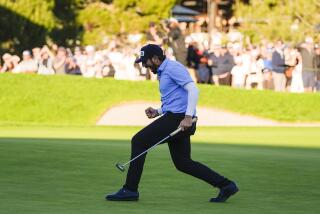BRITISH OPEN : Parnevik Doesn’t Look, Gets Run Over by Price : Golf: Swede ignores the leader board and goes for a birdie at No. 18. Instead, he gets only feathers.
- Share via
TURNBERRY, Scotland — If only Jesper Parnevik had stolen a glance. Sneaked a peek. Overheard a whisper from the gallery. Maybe then the 123rd British Open championship would belong not to Nick Price, but to Parnevik, who picked the worst time Sunday to ignore the two largest scoreboards in all of golf.
But that’s what he did, and Price has the prized Claret Jug and a second major title to prove it.
“Oh, boy,” said Price, whose four-under 66 put him at 12-under for the tournament, one shot shy of the Open record set last year. “I think it was back in 1982 I had my left hand on this trophy. In 1988, I had my right hand on this trophy. Now at last I finally got both hands on it . . . and does it feel good.”
Price knows his history. Twelve years ago at Troon, he blew a three-stroke lead in the final round and finished tied for second. At Royal Lytham in 1988, almost the same thing.
Back then, though, he was losing to the likes of Tom Watson and Seve Ballesteros. Sunday on the Ailsa Course he faced Parnevik, who was making only his second British Open appearance. It showed.
“It’s like a fairy tale,” Price said.
This was Price’s fifth victory of the year, his 15th since winning the PGA Championship in 1992. But it was the first time all season that he played a major as if he belonged. Price didn’t break par in four rounds at the Masters and didn’t make the cut at the U.S. Open.
But when he arrived at Turnberry, saw the way the course was set up, saw the forecasts for warm weather in the final days, Price knew he had a chance.
“I can’t tell you how much I’ve wanted this day to happen,” said Price, who kept alive the streak of non-American victories in this year’s majors.
It happened because Price, of Zimbabwe, finished the final three holes birdie-eagle-par while the rest of the contenders couldn’t keep up.
Try doing that with your heart beating 250 times a minute, as Price said his was with a championship at stake.
It happened because he recorded a great up-and-down from almost the back of a BBC trailer positioned near the green of the 440-yard par-four 14th.
And it happened because of Parnevik’s stubbornness.
Parnevik had stood over his second shot barely off the fairway on the 432-yard 18th hole needing only a par four to finish at 12-under for the tournament, good enough to stay two strokes ahead of Price, who was back on the par-five 17th.
But Parnevik, playing in only his second British Open, had other ideas.
“I thought I needed another birdie on 18 to win,” he said.
What he really needed was a look at one of the two scoreboards that flanked the 18th green. Had he done so, Parnevik would have realized what everyone else on the Ailsa Course, including the desperate Price, already knew: that a par meant safety, meant Price would have to make up two strokes in two holes to tie, three to win.
Problem was, Parnevik decided way back on No. 12 not to consult the scoreboards for the rest of the final round. He figured if he kept making birdies it wouldn’t matter what the rest of the field was doing.
But it did matter. Every time Parnevik sank a birdie putt--and he did so at 11, 12, 13, 16 and 17--someone in the two twosomes behind him birdied, too. Except Parnevik didn’t know who was sinking the putts.
Was it Fuzzy Zoeller or Brad Faxon, the two Americans who began the day at nine under and tied for the lead? Was it Price or Ronan Rafferty, who started at eight under?
Incredibly, the same sort of thing happened to Ernie Els at the U.S. Open. But Els recovered. Parnevik didn’t.
Not knowing the exact situation, Parnevik kept pushing, instead of pausing.
Standing in the light rough of the 18th, Parnevik took a pitching wedge from his bag and went for the pin. The ball landed short and left of the green and then settled down in the lush grass. Parnevik could put the chip no closer than six feet from the hole. He missed the putt for par.
“The way it turned out, maybe I should have taken a glimpse on 18,” Parnevik said.
Price looked at scoreboards. Early and often.
He saw the five-way tie for the lead shortly after making the turn at No. 9. He knew he was flirting with a bogey, maybe worse at No. 14. And he absolutely knew he had to birdie the par-four, 410-yard 16th and at least birdie No. 17.
“I’m not one of those who say they don’t look at the leader board,” Price said. “You have to base a lot of your tactics and strategy on what the other guys are doing.”
Price’s improbable par save on No. 14 was the beginning of the real charge. With marshals and spectators holding up TV cable near the back of a BBC trailer positioned near the green, Price used a seven-iron to chip within four feet of the cup. It was a shot he had been practicing all week. He made the putt.
“He got up and down from there?” Faxon said. “Wow. From that pin?”
Said Price’s caddie, Jeff (Squeeky) Medlen, who carried John Daly’s bag when he won the 1991 PGA: “That chip shot that he ran--that saved the tournament.”
The eagle on No. 17 won it. On the edge of the green in two, Price found himself on the flattest part of the putting surface. As he and Medlen walked toward the ball, Price said, “We haven’t made a long putt all week.”
Then he studied the line and sank the downhill, 51-foot putt.
“I couldn’t believe it went in,” Price said. “I just about jumped out of my skin.”
Parnevik, who was in the scorer’s trailer at the time, didn’t see the putt on television. In fact, Watson had congratulated him on the supposed soon-to-be victory.
But then came a roar from the gallery as Price’s score was put on the giant scoreboards around the 18th. A red star--for leader--was placed next to his name.
Price still needed a par to win. But unlike Parnevik, he played it safe. Left with only a seven-iron--his favorite club--to the green, Price stuck the shot in the middle, two putted and got his trophy.
Afterward, there were hugs aplenty. Price hugged his coach, David Leadbetter, who then declared Price the runaway No. 1 player in he world at the moment. No one argued.
Price hugged his caddie, who then hugged his fiance. The victory meant Medlen could afford to get married in Hawaii. Nearby, a tournament official used a Swiss army knife to cut off the top of the 18th flagstick. Squeeky wanted the flag for his collection.
Medlen could keep the flag. Price had his Claret Jug.
“The golfing gods certainly shone down on me today,” Price said.
Maybe next time Parnevik will remember the moral of Price’s story: Look before you hit.
More to Read
Go beyond the scoreboard
Get the latest on L.A.'s teams in the daily Sports Report newsletter.
You may occasionally receive promotional content from the Los Angeles Times.










